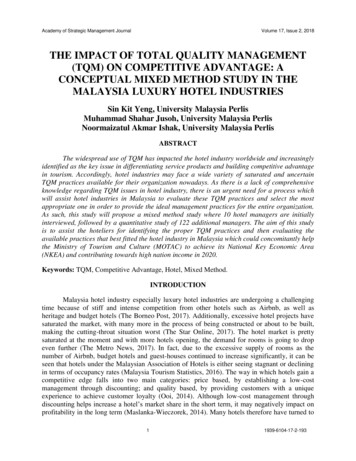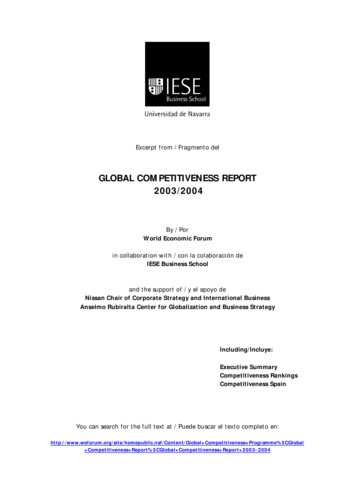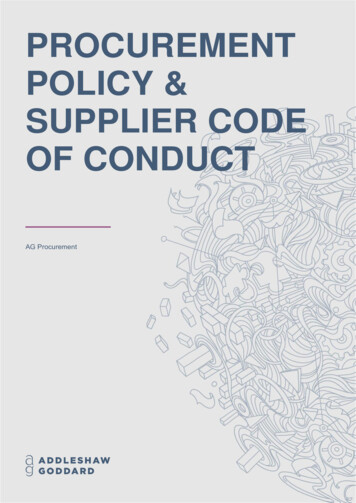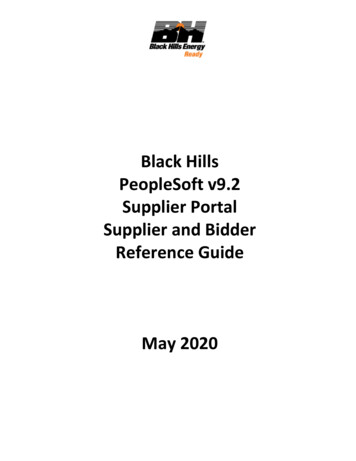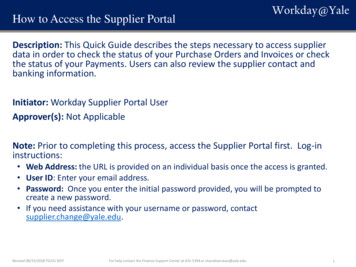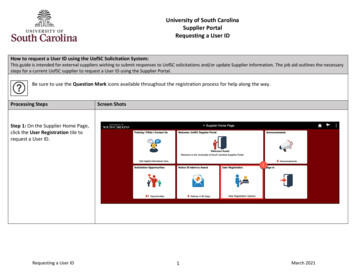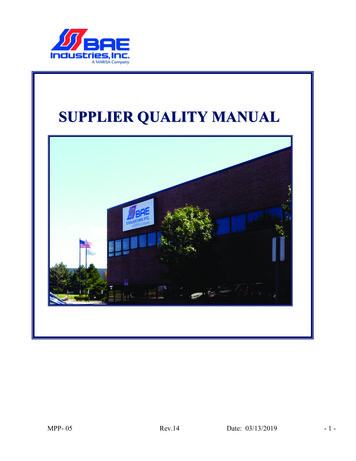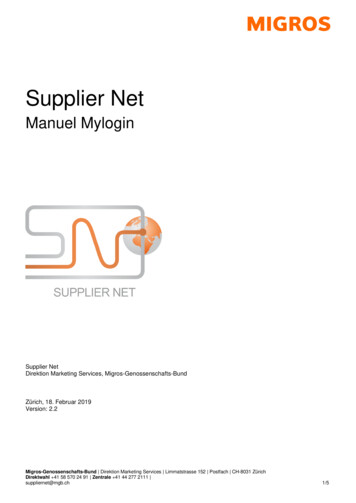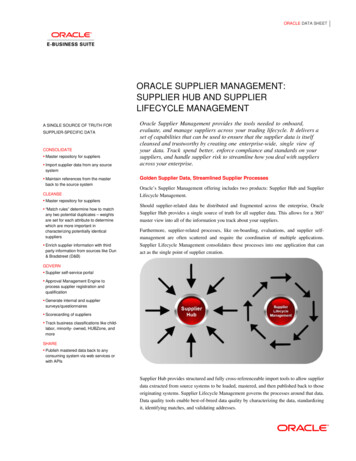
Transcription
2019 International Conference on Strategic Management (ICSM 2019)Analysis of Supplier Competitiveness in Supply Chain ProfitDistribution from the Perspective of Quantity Supplied and PriceResearch Based on Cournot Model and Bertrand ModelHong Yang1,a,*, Naihan Guo1,b12School of Business Administration, Jincheng College of Sichuan University, XiYuan Avenue,Chengdu, ChinaHough Graduate School of Business, University of Florida, Hough Hall 32611, Gainesville, theUnited Statesa125611083@qq.com, b nguo1@ufl.edu*Corresponding authorKeywords: supply chain, Cournot model, Bertrand model, quantity supplied, price competitionAbstract. The relationship between retailers and suppliers is an important link in supply chainmanagement. With the formation of buyer's market, the competition between suppliers and retailersis becoming increasingly fierce. This paper uses Cournot model and Bertrand model to study howsuppliers enhance their competitiveness from the perspective of quantity supplied and price toobtain more profit distribution rights in supply chain.1. IntroductionNowadays, the true portrayal of the poor operation of some logistics enterprises (hereinafterreferred to as logistics suppliers) manifested in economic depression, small volume of freight, fiercecompetition, Customer drain result from refuse to accept the demand side of cargo owner enterprise(hereinafter referred to as the demand side of logistics). Logistics suppliers in a relatively weakposition want to obtain competitive advantage in the process of cooperation with demand-side oflogistics unless they maintain a competitive and cooperative relationship with each other. In thisessay, the Cournot model and Bertrand model of Game Theory will be introduced to analyze thecompetitive strategies of logistics suppliers.2. Supply Strategy Based on Cournot Competition ModelCournot competition model is a kind of production competition model, which takes supplyquantity as competition means. According to the assumption of Cournot competition model,suppose logistics supplier 1 and logistics supplier 2 provide homogeneous logisticsservice[1].Suppose the logistics supply quantity of logistics supplier 1 is q1 , the logistics supplyquantity of logistics supplier the logistics supplier 2 is q2 , and the total logistics supply quantityexpression is q q1 q2 ; If the demand curve expression of logistics market is q a p (pexpressed as the price of logistics service, a is constant), then the inverse demand functionexpression of logistics market is p(q) a q.Providing the total cost of providing qi unit service products by logistics provider i is ci qi ,where ci is a normal number (i 1,2), which described the competition model of logistics supplier1 and logistics supplier 2 as a strategic competition model[2]. The three elements of the model areas follows:1). Two players: logistics supplier 1 and logistics supplier 2;2). The strategy set of any logistics supplier game is the set of logistics supply quantity whichcan be selected by the logistics supplier, given as [0, );3). The profit function of each logistics provider is:πi (q1 , q2 ) (a q1 q2 )qi ci qi(1)Copyright (2019) Francis Academic Press, UK22DOI: 10.25236/icsm.2019.003
When the supply of logistics service products exceeds the demand, the problem that logisticssupplier 1 and logistics supplier 2 should consider is how to determine the supply of logisticsservice in order to achieve the goal of profit maximization[3]. The following uses the test method ofcontinuous Nash equilibrium to find the Nash equilibrium of game of logistics supplier 1 andlogistics supplier 2. According to the profit function of the logistics supplier, the following equationholds:(2)π1 (q1 , q2 ) (a q1 q2 )q1 c1 q1 q21 ( q2 a c1 )q1π2 (q1 , q2 ) (a q1 q2 )q2 c2 q2 q22 ( q1 a c2 )q2(3)Furthermore, according to the necessary conditions of Nash equilibrium, the Nash equilibrium(q 1 , q 2 ) is the solution of the following two equations: π1 (q1 ,q2 ) 2q1 q2 a c1 0(4) q1 π2 (q1 ,q2 ) q2 q1 2q2 a c2 0(5)The equations of (4) and (5) can be obtained by sorting out the equations:a c2 2c1q 1 (6)q 23a c 2c12 (7)3Then calculate the second derivative of equations (2) and (3) equations, the following results areobtained: 2 π1 (q1 ,q2 ) 2 0 q21 2 π2 (q1 ,q2 ) q22 2 0(8)(9)The computational results of (8) and (9) prove that (q 1 , q 2 ) is the Nash equilibrium of the gamebetween the two suppliers of logistics. When the value of c1 is infinitely close to that of c2 ,a**lim q1 lim q 2 . In conclusion, in order to prevent the demand side of logistics service from3suppressing the market price of logistics service, logistics supplier 1 and logistics supplier 2 shouldcontrol the supply of logistics service product properly in the process of internal competition[4].According to the results of Cournot model, for the sake of avoiding the internal contradiction andkeeping the profit from being eroded by the demand side of logistics service, logistics supplier 1and logistics supplier 2 should have adequate product supply.Cournot competition model is used to describe the market game behavior, therefore, we shouldfind a set of logistics service product supply quantity and a market price that satisfy the marketequilibrium condition, which meet the following two conditions[5]: , logistics demand q(p ) equals q1 q 2 ;1). When service price is P 2). q1 , q 2 is the supply of logistics services that two logistics suppliers are willing and able to .provide at a price of P3). When the supply quantity of logistics supplier 1 and logistics supplier 2 is q 1 and q 2respectively, the market price is:a c 2ca c 2ca c1 c2p a q 1 q 2 a 2 1 1 2 (10)333 When the price is p , the demand is:2a c1 c2q(p ) a p (11)3Because of:a c2 2c1a c 2c2a c1 c2q 1 q 2 1 2 (12)333 )q(p q1 q2 , that is, (11) (12): when the market price is p , the logistics demand isexactly the sum of the supply of logistics services provided by the two logistics suppliers when23
Nash equilibrium. The equilibrium supply on this price can maximize the profit of logistics supplier1 and logistics supplier 2.Through the Nash equilibrium analysis of the Cournot competition model mentioned above, thefollowing three conclusions can be drawn[6]:1). There is competition among logistics suppliers, but more cooperation is needed. Jointingrestrictions on the supply of logistics services can effectively resist the wanton reduction of priceson the demand side of logistics services;2). The equation q(p ) q 1 q 2 is established as long as the service supply of the logisticsprovider is equal to the equilibrium demand of the logistics market. The price of logistics servicesa c1 c2p is determined by the supply and demand relationship in the logistics market, not by3the demand side unilaterally;3). The equation q(p ) q 1 q 2 is established, the equilibrium supply of logistics services atthis price can maximize the profit of the two logistics suppliers.3. Price Strategy Based on Bertrand Competition ModelBertrand competition model is a price competition model, which uses price as a means ofcompetition[3]. The following study will focus on the competitive behavior between the suppliersand the demanders from the perspective of price[7].3.1. Enterprise pricing Strategy under the condition of Homogeneous CompetitionAssuming that logistics supplier 1 and logistics provider 2 choose the prices of p1 andp2 respectively, the market demand for the service products of logistics provider i is as follows:(13)qi (pi , pj ) a pi bpj , i 1,2, i j,In this formula a, b 0, where b 0 measures the degree of substitution of the products of thelogistics supplier j to the products of the logistics supplier i. Similar to Cournot competition model,Bertrand model provides that logistics supplier has no fixed production cost, and the marginal costis a common constant c, where c a. The two logistics suppliers choose their respective prices tocompete in the market. The competition model of logistics supplier 1 and logistics supplier 2 is stillexpressed as a strategic competition model in the essay, the three elements of the model are asfollows:1). Two players: logistics supplier 1 and logistics supplier 2;2). Supposing that the price less than 0 has no meaning, the logistics supplier is free to chooseany non-negative price[8];3). The set of strategy of each logistics supplier's pricing is represented as Si [0, ], i.e., the setof strategy Si is the price pi 0 chosen by the enterprise i;4). There is no difference in logistics services provided by logistics supplier 1 and logisticssupplier 2.When the logistics supplier i chooses price pi and the competitor chooses pj , the profit of thelogistics supplier i is as follows:πi (pi , pj ) qi (pi , pj )[pi c] a pi bpj [pi c], i 1,2, i j(14)According to the necessary conditions for the Nash equilibrium in a continuous case, the Nashequilibrium of the price game (p1 , p2 ) is the following two equations: π1 (p1 ,p2 ) 2p1 bp2 a c 0(15) p1 π2 (p1 ,p2 ) p2 bp1 2p2 a c 0(16)By sorting out the equations of (15) (16), we can obtain:a cp1 p 2 (17)2 b24
Then calculate the second derivative of equations (15) and (16), the following results areobtained: 2 π1 (p1 ,p2 ) p212 π2 (p1 ,p2 )p1 p22 2 0 2 0(18)(19)The calculation of the second derivative further shows that the Nash equilibrium of the game isa c p 2 , i.e., the optimal pricing strategy for logistics supplier 1 and logistics supplier 2.2 b3.2. Enterprise Pricing Strategy Under the Condition of Differential CompetitionConsidering the differences of service quality, timeliness and service region between the twologistics providers, the paper reconstructs Bertrand's competition model[9]. When logistics supplier1 and logistics supplier 2 choose the price of p1 and p2 respectively, the market demand function ofthe two logistics suppliers is as follows:q1 (p1 , p2 ) a p1 βp2(20)q2 (p1 , p2 ) a p2 βp1(21)Where a is a constant, β denotes the degree of substitutability of the service products of twologistics suppliers. β [0 ,1] , when the service products of two logistics providers are notsubstituTable, β 0; When the service products of the two logistics providers are completelysubstituted, β 1, i.e., the greater the β, the stronger the substitution of service products, and themore obvious the homogeneity is[10].The total cost of the logistics supplier is C, and the profit function of the two suppliers can beexpressed as:πi qi pi , pj pi C(22)According to the principle of profit maximization, p i argmaxπi pi , pj is obtained, and thefirst order partial derivation of πi is obtained that is equal to 0: πi a 2pi βpi 0(23) piAccording to the necessary conditions for the Nash equilibrium in a continuous case, the Nashequilibrium of the price game (p1 , p2 ) is the following two equations:a 2p1 βp2 0(24)a 2p2 βp1 0(25)Simultaneous equations (24) and (25) can obtain:ap1 p 2 (26)2 βFinally, calculate the second derivative of equations (24) and (25), and the following results areobtained: 2 π1 (p1 ,p2 ) 2 πp1 p212 (p1 ,p2 ) p22 2 0 2 0(27)(28)The calculation of the second derivative further shows that the Nash equilibrium of this game isa p 2 , i.e., the optimal pricing strategy of logistics supplier 1 and logistics supplier 2 under2 βthe condition of differential competition[11]. It can be seen from the calculation results that thehigher the service substitution and the greater the β value, the greater the profit space of thelogistics supplier.25
4. ConclusionCournot competition model and Bertrand competition model are based on the completerationality of both sides of the game, i.e., the two logistics suppliers in the game know thecompetitor's reaction function, profit, output and pricing decision, etc.Modern enterprises are faced with how to determine supply quantity and price to achieve thegoal of profit maximization, at the same time, there is fierce competition among logisticssuppliers[4]. The model calculation shows that maintaining competitive and cooperativerelationship is conducive to enhancing the overall competitiveness of logistics suppliers andimproving their discourse power during the supply chain distribution mechanism.Through the introduction of Cournot model and Bertrand model and under the duopolycompetition market pattern, the optimal supply strategies of logistics supplier 1 and logisticsa c2 2c1a c1 2c2provider 2 are as follows: q 1 , q 2 . The second derivative calculation further33proves that in order to avoid the demand-side of logistics services taking advantage of thecompetitive advantage of the market to arbitrarily suppress the market prices of logistics services,logistics supplier 1 and logistics supplier 2 should properly control the supply of logistics serviceproducts in the process of competition, therefore, reach the optimal solution of Nash equilibrium.Under the condition that there is no difference in service products, the optimal pricing strategya c. The calculation of thefor logistics supplier 1 and logistics provider 2 is as follows: p1 p2 a c2 bsecond derivative further indicates that p1 p2 is the Nash equilibrium of the homogeneous2 bgame[12]. Under the condition that the service product is different, the optimal pricing strategy ofalogistics supplier 1 and logistics supplier 2 is as follows: p1 p 2 , The calculation of thesecond derivative further manifests thatp1 p 2 a2 β2 βis the Nash equilibrium of the differentialgame. The greater the β value, the higher the service substitution of the logistics suppliers and thegreater the profit space of the logistics suppliers.References[1] Wang, Z. K., & Li, J. (2010). A course in Game Theory. Beijing: Renmin University of ChinaPress, 48-55.[2] Zeng, H., & Wang, W. L. (2016). Evolution of dynamic Cournot Game Model under mixedrational behavior. Statistics and Decision-making,23, 48-50.[3] Gao, J. (2016). Dynamic Cournot Model Analysis of multiple firms based on different marginalcost. Business research,2, 13-18.[4] Wu, W. J. (2013). Research on supplier selection of large Retail Enterprises based on BertrandModel. Modern trade industry,19, 26-27.[5] Terrance, M. H., & Jason, F. S. (1998). Effort levels in a Cournot Nash contest with asymmetricinformation. Journal of Public Economics, 69(2), 195-210.[6] Bischi, G. I., & Lamantia, F. (2002). Nonlinear duopoly games with positive cost externalitiesdue to spillover effects. Chaos, Solitons and Fractals, 13(4), 701-721.[7] DUART M, DAVIES G. (2003). Testing the Conflict Performance Assumption in Business toBusiness Relationships. Industrial Marketing Management, 32( 2), 91-99.[8] Davis S, Hagerty M, Gerstner E. (1998). Return policies and the optimal level of “hassle”.Journal of Economics&Business, 50(5), 445-460.26
[9] McWilliams B. (2012). Money-Back Guarantees: Helping the Low-Quality Retailer.Management Science, 58(8),1521-1524.[10] Chen B, Chen J. (2017). Compete in Price or Service?-A Study of Personalized Pricing andMoney Back Guarantees. Journal of Retailing, 93(2), 154-171.[11] Li X. (2007). Coordination mechanisms of supply chain systems. European Journal ofOperational Research, 179(1), 1-16.[12] Ma P, Wang H, Shang J. [2013]. Supply chain channel strategies with quality and marketingeffort-dependent demand. International Journal of Production Economics, 144(2), 572-581.27
Nash equilibrium. The equilibrium supply on this price can maximize the profit of logistics supplier 1 and logistics supplier 2. Through the Nash equilibrium analysis of the Cournot competition model mentioned above, the

